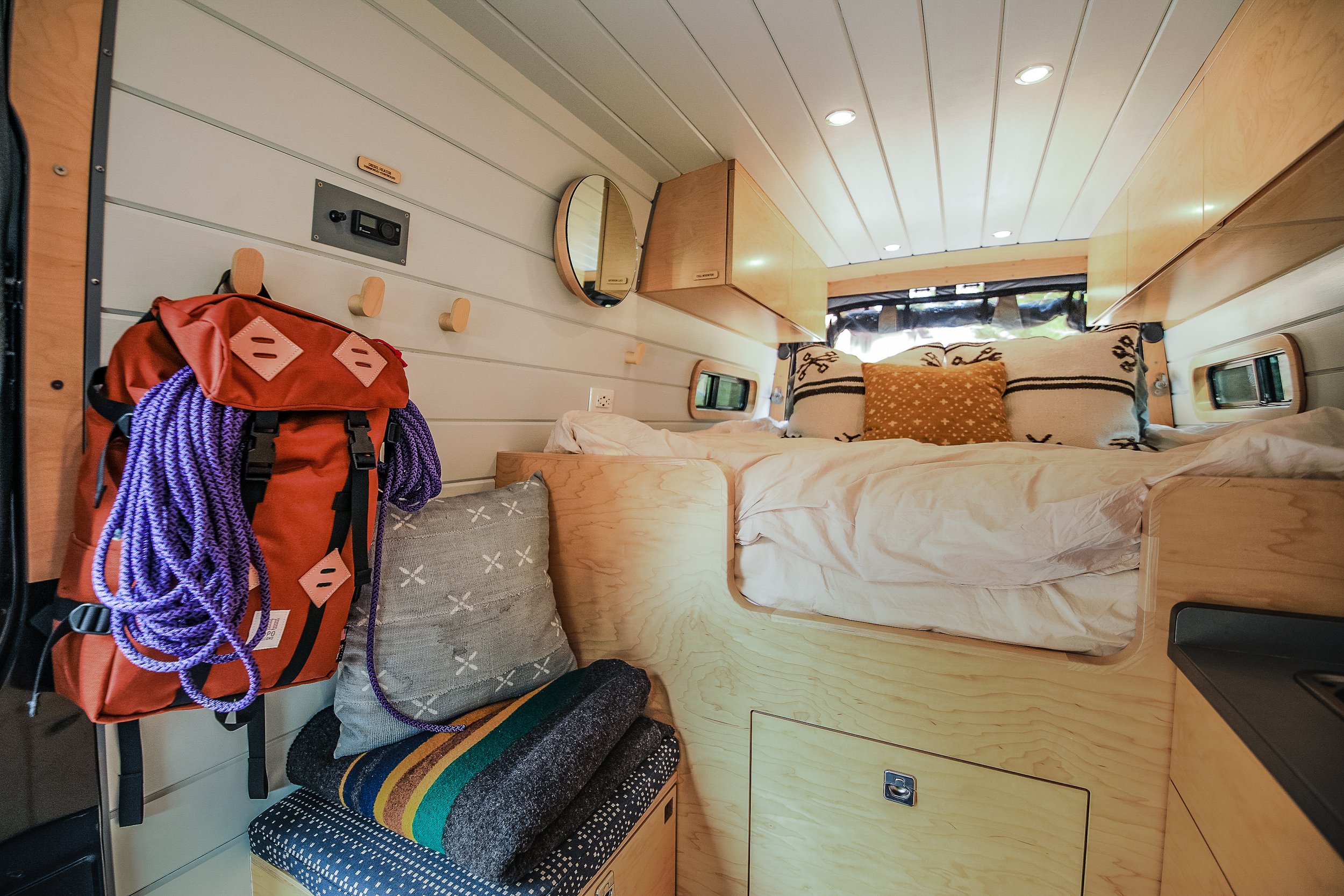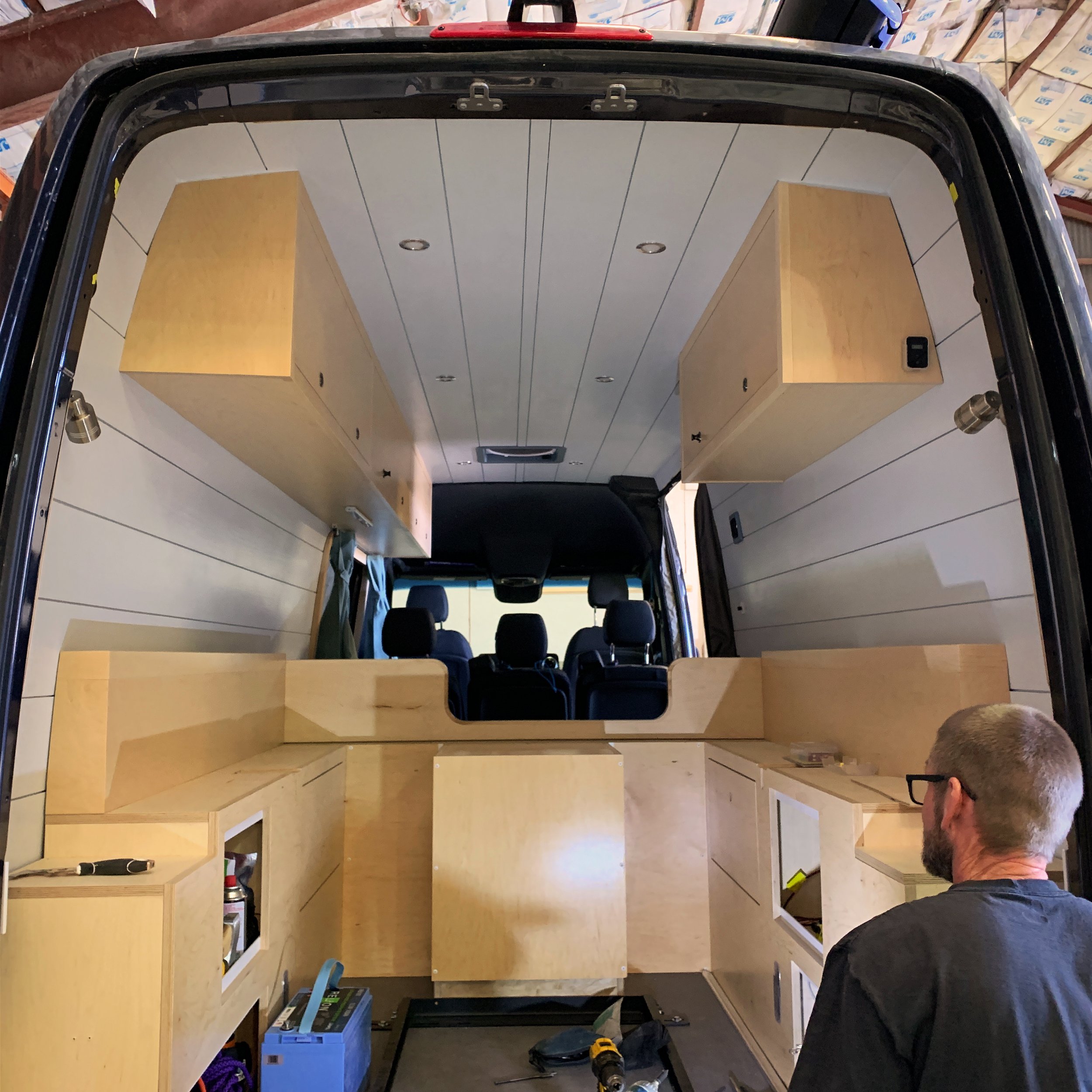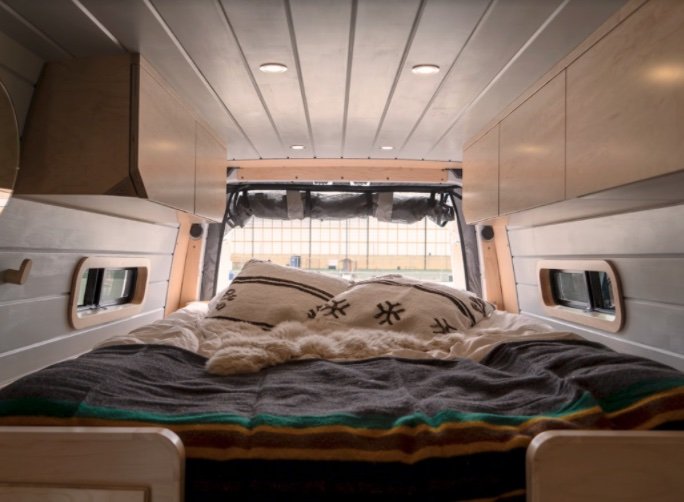DIY Sprinter Van Build vs. Professional Conversion Company: Pros and Cons

Photo by Muse & Co. Outdoors
Tackling a van conversion project yourself can be rewarding, but it is a truly massive undertaking and many people do not understand the implications of such a project. If you are trying to decide between a DIY van conversion and hiring a professional camper van builder, you should start by educating yourself on the pros and cons of each route. Keep reading this article to learn more about DIY vs. professional Sprinter van builds.

Photo by Muse & Co. Outdoors
The True Cost of a Sprinter Van Conversion
The main reason that most people decide to take on a van conversion themselves is cost. And with good reason: By cutting out labor costs, DIYers can save thousands of dollars by converting their own van. Of course, the old adage will tend to apply here: “you get what you pay for”. While you can save a lot of money doing a van conversion yourself, you need to be reasonable about how the end result will compare to a professional conversion.
Plus, while the DIY route will almost always be cheaper than hiring a conversion company, there are many costs associated with converting a van that most people overlook when starting their conversion, leading many DIY builds to end up over budget. A few of the “hidden” costs of converting a Sprinter van yourself include:
- Tools: A van build is an extremely involved project, requiring a variety of skills from plumbing, to electrical wiring, to carpentry and cabinetry. Each of these aspects of the build requires specialized tools. Simply put, converting a van properly requires A LOT of tools. Be sure to factor the cost of tools into your overall budget.
- Hardware, fittings, wiring, and other hidden building material costs: When most DIYers create a budget for their van build, they include the cost of major appliances like a fridge, heater, lights, etc. Many even factor in the cost of wood required to build the cabinets and walls. But a huge cost that many people overlook is that of the varied hardware, plumbing and electrical fittings, electrical wires, and other random fasteners and doo-dads that are inevitably required in a van build. While none of these items costs very much individually, they can quickly add up and eat into your overall budget.
- Mistakes: Some people that build their own van conversions are lucky to already have expert carpentry skills. Others might be familiar with propane systems or 12-volt electrical wiring. But even if you are lucky to have some relevant experience, you are almost certain to encounter parts of your van conversion that are totally new to you. Most DIY van builders make several mistakes during the process, and depending on the situation, these can be costly and require repurchasing of parts and/or lengthy setbacks.
Sprinter Van Resale Value: DIY vs. Professional Conversions
Some van owners buy a van and keep it for decades. But unexpected things happen, even to those who plan on owning their Sprinter van for a long time. Like a car or house, a Sprinter camper van should be treated as an investment, and resale value should be considered when planning your build.
Unsurprisingly, professional van conversions tend to hold their value much better than DIY builds. Even a DIY build of comparable quality to a professional one (a rarity) is likely to sell for less than its pro-built counterpart, simply because buyers can’t reference the builder and check their reputation.
Camper van resale value is an important consideration for any prospective Sprinter van owner. It is not uncommon in today’s market for a professionally-built van to resell with tens of thousands of miles on it for as much or more than the cost of the brand-new van and conversion. Why? Because most camper van builders have long waitlists and some buyers are willing to pay a premium for a used camper van that they can have immediately.
Insurance
Insuring a converted camper van can be simple, but it is also sometimes extremely difficult. Since Sprinter vans start out as cargo vehicles and are converted into campers, they sometimes don’t meet an insurer’s definition of an “RV”. Insuring your van as a passenger vehicle won’t work, because the value of the conversion itself will not be covered.
Fortunately, most major insurance companies now recognize converted camper vans as a legitimate RV, as long as they are converted by an accredited builder. This is bad news for DIY builders looking to insure their camper van, as they will have many more hoops to jump through to get their van and conversion properly insured. Insurance is yet another reason why hiring a professional van conversion company is a safer and easier choice.

Photo by Muse & Co. Outdoors
Build Quality
When it comes to the quality of a Sprinter van conversion, there are a lot of factors. Build materials used, craftsmanship, components included, and durability of the build should all be considered. It would certainly be unfair to say that all professional camper van builds have higher build quality than all DIY builds; there are some truly craftsman-quality home-built camper vans out there, just as there are some conversion companies looking to make a quick buck by cutting corners in their build process.
Chances are, if you’re reading this article, you are not one of the few at-home craftsmen who have the time, tools, expertise, and resources to produce a truly professional-quality van conversion. A truly quality camper van conversion is hallmarked by a beautiful interior, intuitive functionality, and the ability to hold up to harsh road conditions for years to come. In an environment like a camper van, converting a van with true quality requires a master level of craftsmanship. Not only are none of the interior surfaces of a van square or level, but the van is a moving environment and the build-out needs to be able to handle the elements as well as the bumps of the road.
If you choose to go with a professional van conversion company for your Sprinter build-out, make sure to choose a builder that meets the highest standards for craftsmanship and overall quality. If you are looking for the top Bay Area Sprinter camper van builder, look no further than Muse & Co. Outdoors! Muse & Co. Outdoors creates some of the most beautiful, state-of-the-art Sprinter van conversions on the market today. Our builds feature cutting-edge sustainable materials and components, elegant and functional layouts, and plenty of versatility to fit your lifestyle. Check out our “build my van” tool to start exploring your options today!

I would like to comment on the industry trends of making kits for DIYers to build out their vans easier with less tools, time and money.